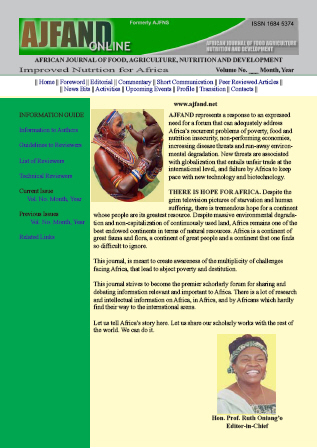
|
African Journal of Food, Agriculture, Nutrition and Development
Rural Outreach Program
ISSN: 1684-5358
EISSN: 1684-5358
Vol. 8, No. 3, 2008, pp. 265-277
|
 Bioline Code: nd08025
Bioline Code: nd08025
Full paper language: English
Document type: Research Article
Document available free of charge
|
|
|
African Journal of Food, Agriculture, Nutrition and Development, Vol. 8, No. 3, 2008, pp. 265-277
| en |
Factors Likely To Enhance Mycotoxin Introduction Into The Human Diet Through Maize In Kenya
Moturi, Wilkister K. Nyaora
Abstract
Moulds probably contaminate and spoil more foods than any other groups of microorganisms. They render contaminated food not only unpalatable, but also unsafe for consumption by producing toxins. In Kenya, several incidences of acute food poisoning due to mycotoxins have occurred, and especially through the staple food, maize. Chronic exposure to mycotoxins has been linked to liver cancer, hepatitis infections, impaired immunity and stunted growth in children. Several factors may enhance the occurrence of mycotoxin in the human diet in Kenya. These include eating habits, existing marketing problems which encourage long storage periods; the pre and post harvest practices that encourage build up of moisture and thus encourage mould growth; lack of preparedness in handling the large quantities of maize produced due to the success of hybrid maize technology, ignorance and poverty. This is aggravated by the fact that there are no strict regulations that impose limits on the concentration of mycotoxins in maize that is marketed in the country as well as lack of relevant technology required in monitoring fungi and mycotoxins in the grains. Mechanisms put in place to deal with such situations can be successful, only if the several factors that contribute towards this situation are well understood. The paper discusses these factors and gives some recommendations for action and further research. The recommendations include coming up with agronomic practices that discourage mould growth; improved pre and post harvest practices; nutritional education and induction of behavioural change as regards food habits; efficient and functioning systems of marketing and pricing of domestically consumed maize, especially within the East African Community; research to identify factors leading to S-strain dominance in semi-arid regions of Kenya; identification of non toxic strains that are highly effective against the S-strain; research on how malnutrition aggravates aflatoxicosis and use of additives and other methods for rendering poor quality grain safe for consumption.
Keywords
diet, factors, hepatitis, maize, mycotoxins.
|
| |
© Copyright 2008 -Rural Outreach Program
Alternative site location: http://www.ajfand.net/
|
|
